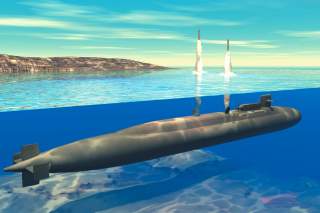The Navy Just Tested Its Most Deadly Nuclear Missile Ever (from a Submarine)
A warning to North Korea?
The Navy test-fired two unarmed Trident II D5 nuclear missiles March 26, as part of an effort to assess various upgrades and sustain an undersea nuclear attack option amid a quickly-changing threat landscape, service officials said.
The weapons were fired off the coast of Southern California from the USS Nebraska, a nuclear-armed ballistic missile submarine.
The missile launch also represents next steps in an ongoing Navy-Lockheed effort to modernize the 1980s-era weapon for service through the next several decades. The US nuclear arsenal has taken center stage in light of the Pentagon’s new Nuclear Posture Review (NPR) and Russia’s recent announcements claiming new advanced nuclear attack capabilities.
Recommended: North Korea’s Most Lethal Weapon Isn’t Nukes.
Recommended: 5 Worst Guns Ever Made.
Recommended: The World’s Most Secretive Nuclear Weapons Program.
The Pentagon’s NPR not only calls for aggressive nuclear weapons modernization and the introduction of new low-yield nuclear weapons but also heavily emphasizes the need to maintain and modernize its current, and somewhat aging, inventory of air, land and sea nuclear weapons.
Seen in this light, the test is fundamental to an ongoing Trident II D5 life-extension program aimed at ensuring the weapon can serve well into the 2040s and beyond.
Capt. Mark Behning, deputy director, Strategic Systems Programs, SSP called the test “an important demonstration of the reliable and credible sea-based leg of the US nuclear deterrent triad," according to a Navy statement.
The missile was converted into a test configuration using a test missile kit produced by Lockheed Martin that contains range safety devices, tracking systems and flight telemetry instrumentation, a Lockheed statement said.
The Trident II D5 is a massively destructive weapon designed to keep international peace by ensuring an undersea-fired second-strike ability in the event of a catastrophic nuclear first-strike on the US. The 44-foot long submarine-launched missiles have been serving on Ohio-class submarines for 25 years. The three-stage ballistic missile can travel a nominal range of 4,000 nautical miles and carry multiple independently targeted re-entry bodies, according to Lockheed information.
The missiles are also being planned as the baseline weapon for the Columbia-class ballistic missile submarines.
Navy Strategic Systems leaders have emphasized the need for long-term sustainment of the triad’s sea-based leg, which the Navy plans to maintain to 2080.
The Navy has also been working on the missile's Mk-6 guidance system to continue specific work on the weapon's electronic modules, Navy developers have said.
As part of the technical improvements to the missile, the Navy is upgrading what’s called the Mk-4 re-entry body, the part of the missile that houses a thermonuclear warhead. The life-extension for the Mk-4 re-entry body includes efforts to replace components including the firing circuit, Navy officials explained.
Navy and industry engineers have been modernizing the guidance system by replacing two key components due to obsolescence – the inertial measurement unit and the electronics assembly, developers said.
The Navy is also working with the Air Force on refurbishing the Mk-5 re-entry body which will be ready by 2019, senior Navy officials said.
Navy officials said the Mk-5 re-entry body has more yield than an Mk-4 re-entry body, adding that more detail on the differences was not publicly available.
The missile also has a larger structure called a release assembly which houses and releases the re-entry bodies, Navy officials said. There is an ongoing effort to engineer a new release assembly that will work with either the Mk-4 or Mk-5 re-entry body.
Within the last several years, the Navy has acquired an additional 108 Trident II D5 missiles in order to strengthen the inventory for testing and further technological development.
The U.S. and UK are collaboratively working on a common missile compartment for their next generation SSBNs or Columbia-Class ballistic missile submarines.
The 130,000-pound Trident II D5 missile can travel 20,000-feet per second, according to Navy figures. The missiles cost $30 million each.
The "Bulletin of the Atomic Scientists" further describes the weapon -- "The Trident D5s carry three types of warheads: the 100-kiloton W76/Mk-4, the 100-kiloton W76-1/Mk-4A, and the 455-kiloton W88/Mk-5 warhead, the highest-yield ballistic missile warhead in the U.S. arsenal."
This first appeared in Warrior Maven here.

